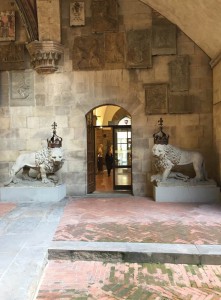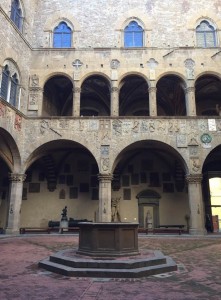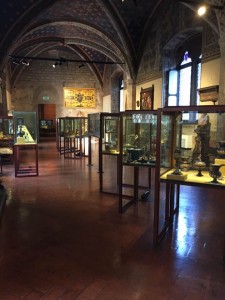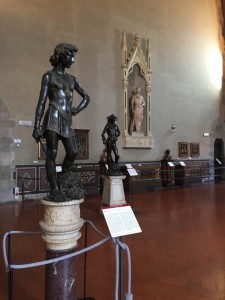

By Rachyl Grussing (Istituto Lorenzo de’ Medici)
The Bargello, also known as the National Museum, was built in 1255 and is one of the older buildings in Florence. While originally it was the headquarters for the Captain of the People, the building went through many changes. It was also the headquarters for the police captain, a barracks, and served as a prison throughout the entire 18th century. It began its career as a museum in the mid-nineteenth century and today it houses important works by Giambologna, Donatello, and the famous Michelangelo.
Although the Bargello has explanatory panels in the main courtyard about the history of the building and the works contained within, nothing within the museum gives a sense of the rich and the full story of the space. This seems to be the main theme with the displays at the Bargello, a disconnect between the history of the objects and their display as objects of aesthetic appeal. The labels on the first and second floor are simple labels detailing only the name and material of the object. There are explanatory panels in each room explaining the theme of the room, giving a map of the cases so the visitor may understand the progression of the space and how these objects came to be at the Bargello, but it does not give full justice to the artworks.
Even within the separate rooms of the upper stories there is a disconnect. Each room contains objects with a different focus. There are rooms displaying items from the Carrand Collection, from the Bargello’s collection of ivory sculptures, and a room only display working from their collection of Maiolica. The rooms, both individually and overall, do not have cohesion. The panels do not do enough to justify the importance of the collection to the visitor, and the sheer number of items on display is enough to numb any mind to the beauty of these objects. When taken as a whole, the rooms tell individual stories rather than contributing to a cohesive whole.
The lower two floors of the Bargello are fairly tourist friendly. The ground floor holds the works of Michelangelo, surrounded by benches that art students take full advantage of, and the first floor is where the two famous David statues by Donatello and Verrocchio stand near each other. The third floor only contains label in Italian, although some works by the famous della Robbia family are displayed there. Looking at the display of arms and armaments of the Bargello, it is clear to see that the third floor follows a typographical display rather than a contextual one.
What an institution like the Bargello needs is a back-to-the-drawing-board approach to its collection and to its displays. With an immense and impressive history to draw upon, and a historic site that contains cavernous halls and bedecked rooms, it would be easy to improve the quality and cohesion of the displays at this institution. New signage marking paths, less items with individual labels that speak more to the objects, rather than one explanatory label for an entire room, and the thread of a larger story throughout the museum would make it more easily accessible to the everyday visitor.


Traduzione di Tania Mio Bertolo (Università degli Studi di Firenze)
Il Bargello, conosciuto anche come Museo Nazionale, fu innalzato nel 1255 ed è uno tra i più antichi edifici di Firenze. Costruito originariamente come sede per il capitano del popolo, il palazzo subì numerosi cambiamenti nel corso dei secoli. Fu in seguito sede del Podestà, poi caserma, e divenne anche prigione fino al secolo XVIII ed oltre. Fu adibito a museo verso la metà del secolo XIX ed oggi ospita importanti lavori di Giambologna, Donatello e Michelangelo.
Nonostante nel cortile centrale siano collocati dei pannelli che descrivono la storia del palazzo e delle opere ivi conservate, all’interno del percorso museale non vi è alcuna suggesione della ricca e importante storia dell’edificio del Bargello. Questa lacuna sembra essere anche la cifra dell’allestimento della collezione permanente: la mancanza di coesione tra l’eredità storica delle opere e la loro messa in mostra in qualità di oggetti di valore estetico. Le targhette didascaliche del percorso espositivo che attraversa il primo ed il secondo piano sono molto semplici, ed indicano soltanto il titolo ed il materiale degli oggetti artistici in mostra. In ogni ambiente sono collocati pannelli esplicativi che introducono al tema della stessa sala, e sui quali è inoltre tracciata una mappa utile al visitatore per comprendere la successione degli spazi dell’allestimento e le circostanze di acquisizione dei capolavori da parte del museo. Purtroppo tali pannelli non danno giusto merito alle opere d’arte.
La suddetta mancanza di coesione si riscontra anche nelle sale più separate, quelle collocate nel piano più alto. Qui ciascuna sala è dedicata ad una tematica: alcune di esse, tra le quali ve ne è una che conserva unicamente la raccolta di avori, sono dedicate ai lavori artistici provenienti dalla collezione Carrand, ed un’altra è invece destinata all’esposizione di maioliche. Queste sale sono prive di coesione sia dal punto di vista individuale che d’insieme: i pannelli esplicativi non valorizzano a sufficienza la collezione del museo al visitatore, ed il numero totale degli oggetti esposti è talmente elevato da decocentrare chiunque dalla bellezza degli oggetti stessi. Nell’insieme, le stanze raccontano singole storie invece che contribuire ad un’unione d’insieme.
Gli allestimenti dei due piani sottostanti, il primo ed il secondo nel palazzo, sono pensati per essere più facilmente fruibili e comprensibili da parte del visitatore. Al piano terra trovano spazio alcuni capolavori di Michelangelo, circondati da sedute utili per gli studenti d’arte; al primo piano sono invece collocate le due famose sculture di David, nelle versioni di Donatello e Verrocchio, situate l’una vicino all’altra. Il terzo piano contiene solo targhette esplicative in lingua italiana, nonostante siano qui conservate alcune robbiane. Osservando l’allestimento della sala destinata alle armi ed alle armature, è chiaro che la scelta espositiva del terzo piano segua un carattere tipografico piuttosto che contestuale.
Quello di cui un’istituzione come il Bargello avrebbe bisogno è un approccio retrospettivo alla propria collezione ed alle proprie soluzioni espositive. Con una storia così corposa ed importante dalla quale attingere, ed un palazzo antico che ancora conserva ambienti cavernosi e sale decorate, sarebbe facile migliorare la qualità e la coesione degli allestimenti di questa istituzione. Nuovi pannelli esplicativi che caratterizzano il percorso, un numero inferiore di oggetti artistici esposti ma ciascuno con la propria targhetta descrittiva piuttosto che un unico pannello che introduca all’intera sala, ed un filo conduttore che muova attraverso gli ambienti del museo per renderne manifesta l’eredità storica: tutto ciò renderebbe più facile e piacevole il godimento della collezione da parte del visitatore.